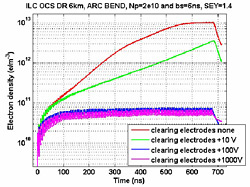Director's Corner
5 October 2006
 Barry Barish |
The Evolving ILC Design: Eliminating One Positron Damping Ring
We have planned from the beginning to quickly create an initial baseline and as a result of technical developments, evolve it in time. Our Baseline Configuration Document explicitly includes a number of alternatives that we consider to be very good candidates for replacing the baseline as soon as more R&D or technical studies have been completed. Based on one such technical development, we recently changed the baseline by eliminating one of the two positron damping rings. Our original baseline used two damping rings that received alternate bunches. The resulting longer bunch spacing reduced the problem of electron cloud effects; however this was a complicated and expensive solution. New studies of alternate methods for mitigating electron cloud effects have given us enough confidence to eliminate one positron ring. This action saves an entire damping ring and thereby realises a significant cost savings.
 Electron Cloud build-up and suppression using clearing electrodes. |
"Electron cloud" effects result from the positron beam interacting with photo-electrons that come off the walls of the vacuum chambers. The magnitude of the effect depends on details of the vacuum chamber design, the materials, and the presence of external fields. The significance of this "issue" was clearly identified by our damping ring group in making their recommendation for the ILC damping ring baseline configuration:
"Electron cloud effect (Significance: A) Shorter rings have a closer bunch spacing, which greatly enhances the build-up of electron cloud. Electron cloud can be difficult to suppress in the dipole and wiggler regions where it is expected to be most severe, and the instabilities associated with electron cloud could significantly affect the performance of the damping rings."
Concern about this issue motivated them to recommend a baseline configuration with two damping rings:
"The positron damping ring should consist of two (roughly circular) rings of approximately 6 km circumference in a single tunnel. Electron-cloud effects make a single ring of circumference 6 km or lower unattractive, unless significant progress can be made with mitigation techniques."
But they explicitly recognised that further work might enable us to eliminate one damping ring, and they identified a potential "alternative" to the baseline with one positron damping ring:
"If techniques are found that are sufficiently effective at suppressing the electron cloud, a single 6 km, or possibly smaller, ring can be used for the positron damping ring. This will save costs."
Now as a result of the recent studies, we have been able to follow this directive and have officially approved a change request that eliminates one damping ring. Simulation and experimental studies have been carried out on two new techniques for reducing the electron cloud density in the vacuum chambers. The first technique involves using grooved chamber surfaces. Secondary electron yields were found to be significantly reduced in field-free conditions in laboratory environments and tests in an accelerator environment are planned at PEPII at SLAC. The second method is to use cleaning electrodes, and so far simulation studies also indicate significant reduction in the electron cloud density (see figure above).
This particular development is going to require more R&D in the future, especially demonstration experiments to validate the schemes and to guide the final design. These positive results and the resulting baseline change are a very good illustration of the importance and the value of our R&D program on alternatives that we are carrying out in parallel with our ILC design effort.
-- Barry Barish